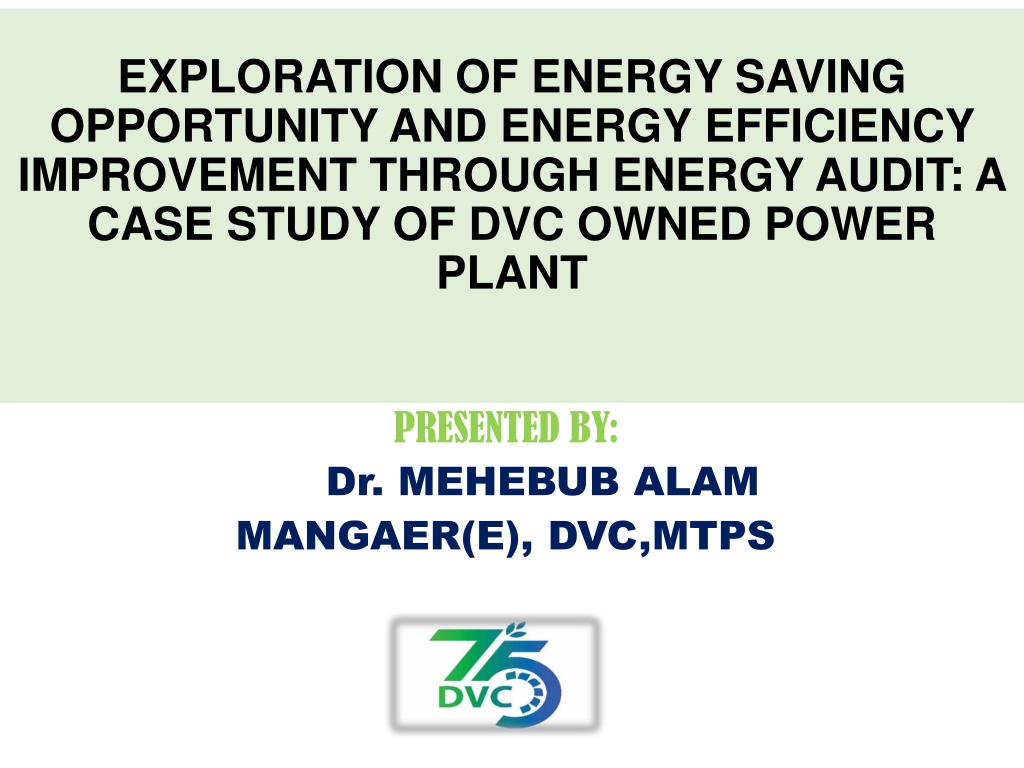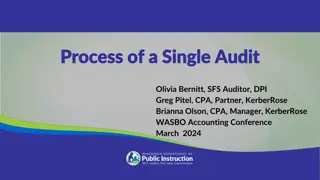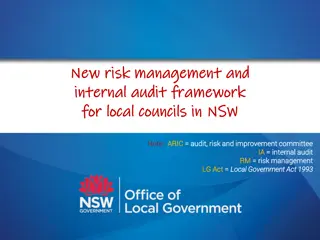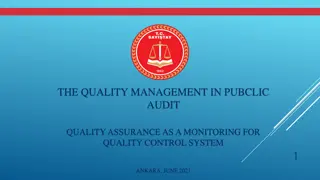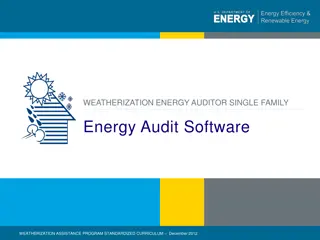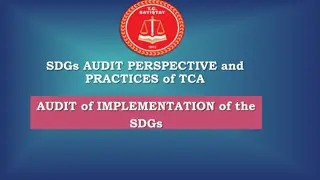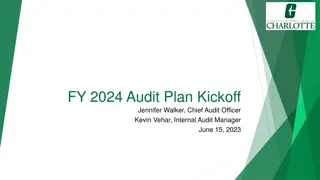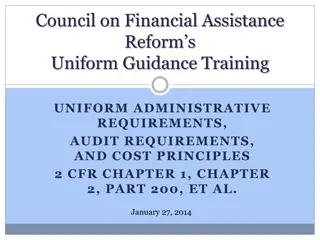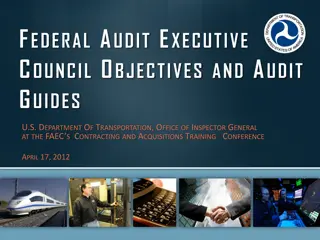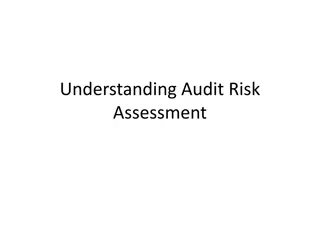EXPLORATION OF ENERGY SAVING OPPORTUNITY AND ENERGY EFFICIENCY IMPROVEMENT THROUGH ENERGY AUDIT: A CASE STUDY OF DVC OWNED POWER PLANT
Dr. Mehebub Alam presented a case study on exploring energy-saving opportunities and improving energy efficiency through an energy audit at a DVC-owned power plant. The audit methodology involved measuring field data, analyzing performance, and assessing overall plant efficiency. Various instruments were used during the audit, including flue gas analyzers, digital anemometers, hygrometers, and power analyzers. The study also included case studies on energy-saving opportunities in compressors and condensate extraction pumps.
Download Presentation

Please find below an Image/Link to download the presentation.
The content on the website is provided AS IS for your information and personal use only. It may not be sold, licensed, or shared on other websites without obtaining consent from the author. Download presentation by click this link. If you encounter any issues during the download, it is possible that the publisher has removed the file from their server.
E N D
Presentation Transcript
EXPLORATION OF ENERGY SAVING OPPORTUNITY AND ENERGY EFFICIENCY IMPROVEMENT THROUGH ENERGY AUDIT: A CASE STUDY OF DVC OWNED POWER PLANT PRESENTED BY: Dr. MEHEBUB ALAM MANGAER(E), DVC,MTPS
OVERVIEW INTRODUCTION ENERGY AUDIT METHODOLOGY INSTRUMENTS USED IN ENERGY AUDIT CASE STUDIES OF ENERGY SAVING CASE-1 (COMPRESSORE): OBSERVATION AND ANALYSIS CASE 2 (CEP): OBSERVATION AND ANALYSIS CONCLUSION
ENERGY AUDIT METHODOLOGY ENERGY AUDIT METHODOLOGY The Energy audit adopts the method of measuring field data using calibrated portable instruments and thermodynamic simulation based analysis to evaluate the performance of individual major components in the plant and also to assess the overall plant efficiency. The performance assessment typically applied to: Comparing actual performance to reference performance Comparing different conditions of the systems and subsystems Analysing the impact of individual equipment performance s variation on overall plant efficiency Assessing different energy efficiency
ENERGY AUDIT METHODOLOGY ENERGY AUDIT METHODOLOGY FIELD SUVEY RECHECK AND EVALUATE PERFORMANCE DATA COLLECTION AND MEASUREMENTS ENERGY AUDIT EXPERIMENTS AND DATA ANALYSIS IMPLEMENTATI ON PERFORMANCE ASSESMENT OF EQUIPMENT COST BENEFIT ANALYSIS
INSTRUMENTS USED DURING ENERGY AUDIT INSTRUMENTS USED DURING ENERGY AUDIT Kane flue gas analyzer: For temperature, CO (ppm) & O2 % of flue Gas. Digital anemometer: For measuring air flow Hygrometer: For measuring temperature, humidity. Power analyzer - KRYKARD ALM-36: Three phase power and harmonic analyzer Portable clamp on multimeter: For measurement of V, I, kW, kVA, P.F. etc. Ultrasonic flow meter: For measuring flow of water Digital temperature indicator: For measuring the temperature at boilers, turbine, condenser, economizer, air pre-heater, flue gas temperature. etc. Non contact infrared digital thermometer: For measuring surface temperature of boiler, steam lines during Insulation audit of Boiler & Turbine. Digital tachometer: For measuring speed of shafts, motors
CASE STUDIES CASE STUDIES A detailed comprehensive energy audit of entire DVC RTPS plant covering various packages/areas such as CHP, BOP, TG, boiler, Electrical system etc. was conducted. Two case studies are presented. Case-1: Energy saving/efficiency opportunity in compressor Case-2: Energy saving/efficiency opportunity in condensate extraction pump
CASE CASE- -1: 1:ENERGY SAVING/EFFICIENCY OPPORTUNITY IN COMPRESSOR ENERGY SAVING/EFFICIENCY OPPORTUNITY IN COMPRESSOR There are 3 nos. Instrument Air Compressors (IAC) and 2 nos. Service Air Compressors (SAC) installed in the RTPS DVC plant. The audit test of a compressor is normally carried out to determine the following Actual free air delivery (FAD) Power consumption Specific power consumption
Free Air Delivery (FAD) test results Free Air Delivery (FAD) test results Description Unit Service Air compressor 1 5.8 Service Air compressor 2 5.8 Set loading pressure Set unloading presuure Total Volume FAD Kg/cm2 Kg/cm2 7.2 7.2 M3 CFM M3/min KW KW 10 1451.96 41.11 344.08 167.8 10 1468.93 41.6 335.22 169.74 power Isothermal Power Isothermal efficiency Specific power consumption (SPC) % 48.76 50.6 KW/100 CFM 23.7 22.82 Design SPC KW/100 CFM % 23.17 23.17 Volumetric efficiency Loading of motor 93.44 94.53 Fig: FAD and specific power consumption % 95.57 93.11
OBSERVATIONS AND ANALYSIS: CASE 1 OBSERVATIONS AND ANALYSIS: CASE 1 The performance of service air compressor is almost similar to design performance and seems satisfactory. Volumetric Efficiency of the compressor is found to be around 94% for both the compressor. Both the loading power and unloading power of the compressor has measured and provided in below table 2 While audit, it has noted that the range of set pressure (5.8 kg/cm2 ) and reset pressure (7.2 kg/cm2 ) is around 1.4 kg/cm2 which is slightly higher side. It is recommended to explore the possibility of lowering the delivery pressure settings (6.8 kg/cm2 ) by careful study of pressure requirements of various equipment and pressure drop across the line. Reduce pressure setting of the compressors in steps of 0.1 kg/cm2 . As a thumb rule 1 kg/cm2 reduction in generation pressure results in 8 10% savings in power.
ENERGY SAVING CALCULATION: CASE 1 ENERGY SAVING CALCULATION: CASE 1 Description Unit Service Air compressor 1 7.2 Service Air compressor 2 7.2 Present discharge Pressure Modified discharge Pressure Compressor Power Power saving Annual operating hours Annual energy saving Cost of generation Annual Monetary saving Investment Payback Kg/cm2 Kg/cm2 6.8 6.8 KW 344.1 335.2 KW Hrs 19.12 2655.15 18.62 2655.15 KW/Yr 50755 49448 Rs/Kwh Rs. in Cr. 2.42 0.012 2.42 0.012 Rs. Month NIL Immediate NIL Immediate
CASE-2: ENERGY SAVING OPPORTUNITY ANALYIS IN CEP There are three vertical fixed speed condensate extraction pumps with capacity of 50% are installed in condensing water system for each unit (two are operating with another as standby). The performance of CEPs of both units has been analysed by measuring the flow, discharge pressure, power consumption and recording the condenser vacuum. Based on the measured data operating efficiency of pump have been compared with design parameter. Table : Design specification details of CEP Description Discharge presuure Design capacity Total Head Power rating Unit Kg/cm2 CEP 33.5 M3/hr KW KW 890.8 338 1250
OBSERVATIONS AND ANALYSIS: CASE 2 OBSERVATIONS AND ANALYSIS: CASE 2 In both units Pump A & Pump B were in service .Efficiency of Pump 1A and 1B is found to be 56.68% for both Running Pumps. For unit 2, CEP Efficiency is found to be 58.28% and 58.52% respectively against design of 84.10% The specific energy consumption is found to be 1.45Kw/TPH and 1.18Kw/TPH against design of 1.55. It was observed that CEP Re-circulation Valve was kept Open at both the units for maintaining the lower discharge pressure of CEP. It was noted that flow difference between CEP outlet and de-aerator inlet is found to be around 250 TPH, this flow was re-circulated to Hot well. Moreover, it was also noted that the Discharge pressure of CEP is found approx 28 kg/cm2 for unit 1 and 23 kg/cm2 to 24 kg/cm2 in unit 2, while the De-aerator pressure is found to be approx 9.0kg/cm2 to 10.0kg/cm2 for both units. The recirculation loss by opening the recirculation valve and throttling loss of CEP may be eliminated by installing the variable speed controller
WHY VFD IS USED WHY VFD IS USED VFD are necessary to convert constant frequency and voltage to variable frequency and voltage. This allows us to control motor speed and torque! Hey, use VFD and save energy! Input Inverter Converter DC Voltage Output Variable Frequency Voltage Controlled Non-Regulated Rectifier AC Input Voltage Variable Voltage Constant V/f
ADVANTAGES OF VFD Provide the most energy efficient means of capacity control. Have the lowest starting current of any starter type. Reduce thermal and mechanical stresses on motors and belts. Mechanical weariness of piping is minimum Risk of cavitations in the pump is minimum Controlled and smooth start up
POWER, SPEED, FLOW RELATIONSHIP POWER, SPEED, FLOW RELATIONSHIP A reduction of the pump speed with 10% will save 27% of the consumed power
LOADING AND SEPCIFIC POWER CONSUMPTION LOADING AND SEPCIFIC POWER CONSUMPTION
ENERGY SAVING CALCULATION: CASE 2 ENERGY SAVING CALCULATION: CASE 2 Description Present power consumption Expected saving Proposed Power saving Annual operating hours Cost of generation Annual energy saving potential Annual Monetary saving Investment cost of VDF Payback Unit KW CEP-1B 1075.2 CEP-2B 1151 % KW 20 215.16 20 230.2 Hr 2655.16 2655.16 Rs/Kwh KWh 2.42 571293.02 2.42 611292.91 Rs. in Cr. 0.14 0.15 Rs. in Cr. 0.30 0.30 Month 26.04 24.34
CONCLUSION CONCLUSION The energy manager should prepare action plan for energy consumption and implement the energy saving measures with low/zero capital investment with short term goal. Instrumentation has the key role in energy conservation & management. Regularly calibrated latest instruments should be used to monitor all the energy parameters in order to analyse the efficiency, specific energy consumption On-line/portable instrumentation should be provided for monitoring the energy parameters and performance of system and subsystems. Energy audit is very much effective to explore the energy efficiency improvement area and to identify the energy saving opportunities
Thank you The earth s inhabitants must take a serious look at energy resources, use and conservation
